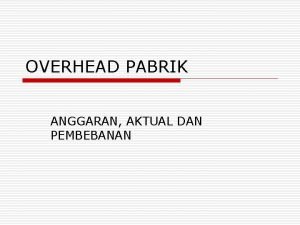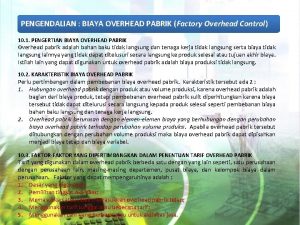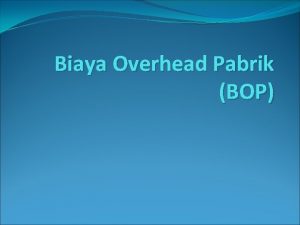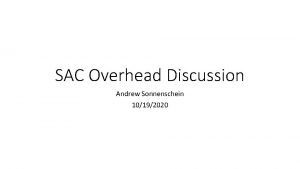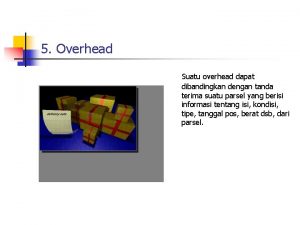Overhead and Performance Study of the General Internet



















- Slides: 19

Overhead and Performance Study of the General Internet Signaling Transport (GIST) Protocol • Xiaoming Fu (Uni Goettingen) • Henning Schulzrinne (Columbia Uni) Hannes Tschofenig (Siemens) • Christian Dickmann, Dieter Hogrefe (Uni Goettingen) Telematics group University of Göttingen, Germany

Telematics group University of Göttingen, Germany Overview • Background and motivation • GIST/NSIS operation overview • Evaluation – Overhead – Performance/scalability – Extensibility • Conclusion Xiaoming Fu (fu@cs. uni-goettingen. de) 2

Telematics group University of Göttingen, Germany Background • Routers nowadays are expected to do more than IP routing and forwarding – NAT, firewall, cache, … – Can also be Qo. S and other boxes – PHB, profile meters, AQM etc… Firewall B Host A NAT 10. 1. 1. 4 Qo. S C New traffic class Host D • Not in harmony with the Internet architecture • Require certain network control state configuration – Network-layer (control) signaling protocol is needed Xiaoming Fu (fu@cs. uni-goettingen. de) 3

Telematics group University of Göttingen, Germany Network Control Signaling Protocol Examples • Path-decoupled (Client/Server) – – COPS MEGACO DIAMETER MIDCOM • Path-coupled – Resource Reservation Protocol (RSVP) • IETF proposed standard for Qo. S signaling (03/97) – IETF NSIS (Next Steps in Signaling) • with Qo. S signaling as first application Xiaoming Fu (fu@cs. uni-goettingen. de) 4

Telematics group University of Göttingen, Germany RSVP review • RFC 2205 • Signaling for Integrated Service Qo. S models (GS, CLS) – – – Per-flow reservation Multicast flow Limited extensibility (objects and semantics specifically for Qo. S) Refreshes: packet losses due to congestion, route changes etc Not adapted to today’s needs: mobility, other signaling purposes (midcom, diagnostics…) – No solid security framework and no support for AAA architecture • RFC 2961: added hop-by-hop reliability and summary refreshes • Other extensions: aggregated reservation, reservation over different networks (MPLS, 802. x) Xiaoming Fu (fu@cs. uni-goettingen. de) 5

Telematics group University of Göttingen, Germany NSIS Framework (RFC 3726) • A two-layer split – Transport layer (NTLP or GIST): message transport – Signalling layer (NSLP): Qo. S NSLP, NATFW NSLP, etc. • Contains the application intelligence • Flexible/extendable multiple signalling application – – Per flow Qo. S (Int. Serv) Flow aggregate Qo. S (Diff. Serv) Firewall and Network Address Translator (NAT) And others Xiaoming Fu (fu@cs. uni-goettingen. de) 6

Telematics group University of Göttingen, Germany GIST: the fundamental building block in NSIS Two names for NSIS transport layer: • NTLP (the basic concept) • GIST (the protocol implementation): General Internet Signalling Transport • Based on the CASP (Cross-Layer Signaling Protocol) that we developed in 2002/03 (ICNP’ 04 paper) • Key design choices believed to enhance RSVP: • Separation of signaling transport from application (two-layer split) • Flexible/extendable message transport (reuse TCP/SCTP/UDP/…) • Reliability/ordering provisioning • Other common transport functions (congestion control, fragmentation, . . ) • Separation of discovery from signaling transport • Introduction of mobility/location-independent session identifier • Also enables several key security properties • Needs to justify/evaluate this design è Main contribution of this paper! Xiaoming Fu (fu@cs. uni-goettingen. de) 7

Telematics group University of Göttingen, Germany GIST: an introduction • GIST responsible for – Transport signalling message through network – Finding necessary network elements • Abstraction of transport to NSLPs – NSLP do not care about transport at all Xiaoming Fu (fu@cs. uni-goettingen. de) 8

Telematics group University of Göttingen, Germany GIST/NSIS Operation: an Overview Need Qo. S! NSLP View Need Qo. S! NSLP Layer Here it is! Need Qo. S NSLP Layer Here it is! Are you my next node? (discovery) Abstraction NTLP View Network View NTLP Layer UDP Transport (GIST D-mode) NTLP Layer NSIS router Router NSIS without Host A NSIS Xiaoming Fu (fu@cs. uni-goettingen. de) TCP connection NSLP Layer NTLP Layer NSIS router NSIS Host B (GIST C-mode) Router without NSIS 9

Telematics group University of Göttingen, Germany Evaluation • Overhead – Will the overhead added by NSIS be too large? • Performance/scalability – Can it be scalable for large number of sessions and nodes? • Extensibility – Can it be easily extended to allow any new signaling applications? • Others (beyond this paper): – Mobility: can it be ran in IP-based mobile networks? – Security: Can it be well protected without much performance penalty? Xiaoming Fu (fu@cs. uni-goettingen. de) 10

Telematics group University of Göttingen, Germany Overhead analysis RSVP -P (52 by ath tes) GIST (112 - -query 144 b 104+ ytes) sv e bytes R rv) e P e S s V t n n S I R espo s) 368+ for r s T e t S GI byte 4 by 0 4 8 1 bytes 1 (72 (148 GIST RSVP (108 b -confirm -Path ytes ( 5 2 byte + dat s) association GIST discovery requires aa)3 -way handshake, 368 bytes for message 104+ setup with additional benefit of security andbytes multiplexing sv e R rv) e P S t V S GIS RSVP need associate and relies on state. Rrefreshes r In T-damessage o f 70+ does not s t a (70 byte B 4 4 s bytes + d ta) (72 -1 For application-specificastate data delivery: GIST data requires only 1 -way, 70 bytes for each NSLP data delivery GIST-d atexchange, a 70+ requires RSVP 104+ bytes for (Qo. S) signaling data delivery (70 by 2 -way tes + d ata) bytes For many application scenarios, message associations can be maintained half-permanent (e. g. hours to days): the 1 -way 70 bytes overhead is tolerable Xiaoming Fu (fu@cs. uni-goettingen. de) 11

Telematics group University of Göttingen, Germany Performance evaluation: testbed Xiaoming Fu (fu@cs. uni-goettingen. de) 12

Telematics group University of Göttingen, Germany Performance: GIST e 2 e signaling latency • GIST scales well in terms of e 2 e signaling delay in large number of sessions – Fairly small (less than 20 ms) under 55 k sessions – Start to become worse when session number grows from more than 55 k • Most likely due to overloaded GIST CPU computation power Xiaoming Fu (fu@cs. uni-goettingen. de) 13

Telematics group University of Göttingen, Germany Performance: how the implementation segments contribute to overall processing XOPP XORP timer Receiving external messages Receiving and distribute to FSM 53% 42% 8% 4% Message parsing Message composing and internal reading Session data management (hash table) NSLP level processing (“ping”) Others 4% 17% 8% 1% 6% Xiaoming Fu (fu@cs. uni-goettingen. de) 14

Telematics group University of Göttingen, Germany Performance: GIST v. s. RSVP (1) • RSVP’s CPU consumption is fairly small in large number of sessions • GIST’s CPU consumption is larger than RSVP - still works with 60 k session bottleneck likely due to the processing of GIST header Xiaoming Fu (fu@cs. uni-goettingen. de) 15

Telematics group University of Göttingen, Germany Performance: GIST v. s. RSVP (2) • GIST’s memory consumption scales well in large number of sessions – Slightly worse than RSVP in serving more than 15 k sessions • Due to the additional message association state – Slightly better than RSVP in serving less than 15 k sessions • Due to our optimization in the code (e. g. , session data management) Xiaoming Fu (fu@cs. uni-goettingen. de) 16

Telematics group University of Göttingen, Germany Extensibility analysis • NSIS allows – GIST to use of any types of discovery mechanism • By defining a new message routing method (MRM) – Definition of any new NSLPs • Support a large variety of transport protocols for GIST – SCTP and PR-SCTP – TCP – UDP (and even DCCP if available) • In the implementation level: – The GIST daemon and GIST-API are developed with sufficient modularity/independency on underlying platforms and NSLPs – Currently we support Linux, x. BSD, and Mac. OSX: fairly easy to port Xiaoming Fu (fu@cs. uni-goettingen. de) 17

Telematics group University of Göttingen, Germany Conclusion • Next Steps in Signaling framework (NSIS) tries to address the modularity, extensibility, transport, and security issues in RSVP – Not only Qo. S signaling, but also generic signaling for any type of middlebox configuration – Fundamental building block: GIST protocol • GIST adds discovery component (thus imposing overhead), but for data transport phase, overhead is comparable as RSVP – the complexity worth the added security, extensibility, and modularity. – The main processing time comes from implementation choice (e. g. , XORP) • GIST performance is comparable with RSVP, with good scalability in e 2 e signaling latency • GIST/NSIS implementation: http: //user. cs. uni-goettingen. de/~nsis • Publications: http: //www. tmg. cs. uni-goettingen. de/publications Xiaoming Fu (fu@cs. uni-goettingen. de) 18

Telematics group University of Göttingen, Germany Thank you! Questions, comments appreciated Xiaoming Fu (fu@cs. uni-goettingen. de) 19
 Perbedaan overhead aktual dan overhead dibebankan
Perbedaan overhead aktual dan overhead dibebankan Effects of internet use and study habits
Effects of internet use and study habits Internet or internet
Internet or internet Hình ảnh bộ gõ cơ thể búng tay
Hình ảnh bộ gõ cơ thể búng tay Ng-html
Ng-html Bổ thể
Bổ thể Tỉ lệ cơ thể trẻ em
Tỉ lệ cơ thể trẻ em Chó sói
Chó sói Glasgow thang điểm
Glasgow thang điểm Chúa yêu trần thế
Chúa yêu trần thế Kể tên các môn thể thao
Kể tên các môn thể thao Thế nào là hệ số cao nhất
Thế nào là hệ số cao nhất Các châu lục và đại dương trên thế giới
Các châu lục và đại dương trên thế giới Công thức tính thế năng
Công thức tính thế năng Trời xanh đây là của chúng ta thể thơ
Trời xanh đây là của chúng ta thể thơ Mật thư anh em như thể tay chân
Mật thư anh em như thể tay chân Phép trừ bù
Phép trừ bù Phản ứng thế ankan
Phản ứng thế ankan Các châu lục và đại dương trên thế giới
Các châu lục và đại dương trên thế giới Thể thơ truyền thống
Thể thơ truyền thống
